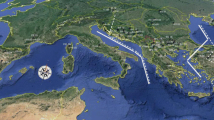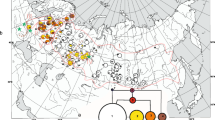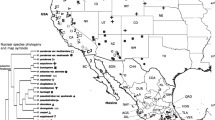Abstract
Recent studies highlighted the potential role of cryptic glacial refugia for temperate taxa in Europe beyond the Mediterranean peninsulas. To further investigate phylogeographic features of the European pine marten (Martes martes) in previously identified cryptic refugia located in central–western Europe, we analysed the hyper-variable diagnostic fragment of the mitochondrial control region in a total of 134 specimens, allowing for reliable comparisons with previous genetic studies of the species. We included samples from eight different European countries in central–western Europe (Belgium, France, Luxembourg and the Netherlands), in south–western Europe (Spain), in north–central Europe (Denmark) and in central Europe (Germany and Poland). The sequences collapsed in 17 haplotypes, which allowed us to determine the genetic composition of the pine marten populations throughout central–western Europe. Overall, our results showed that the population genetic variation, estimated by the standardised haplotype diversity, was high (0.400 ≤ Hs ≤ 0.762), and it was considerably higher in Germany (0.762) and the Netherlands (0.722) compared to the other countries. The nucleotide diversity was relatively low (0.002 ≤ π ≤ 0.016) even in Germany and the Netherlands (0.016 and 0.014, respectively), suggesting relatively small, long-term effective population sizes or severe bottlenecks. Out of the 17 haplotypes found in our study area, 13 were unique and limited to a single country: one in Denmark, one in Spain, four in Poland and seven in the Netherlands. The pairwise genetic distance ranged from 0.001 to 0.032 and did not show any evident correlation with the geographic distances between the populations. A genealogical relationship network was constructed, which provided evidence for a recent origin of many of the unique haplotypes. Approximately 82 % of the samples analysed in this study belonged to haplotypes grouped into a previously identified central–northern European phylogroup of the species. Our results support previous findings, indicating low contribution of southern refugial populations to the postglacial recolonization of central–western Europe and a predominant contribution of pine marten populations that survived the Last Glacial Maxima in cryptic northern refugia.


Similar content being viewed by others
References
Altschu SF, Gish W, Miller W, Myers EW, Lipman DJ (1990) Basic local alignment search tool. J Mol Biol 215(3):403–410
Avise JC (2000) Phylogeography: the history and formation of species. Harvard University Press, Cambridge
Bhagwat SA, Willis KJ (2008) Species persistence in northerly glacial refugia of Europe: a matter of chance or biogeographical traits? J Biogeogr 35:464–482
Bickham JW, Patton JC, Loughlin TR (1996) High variability for control-region sequences in a marine mammal: implications for conservation and biogeography of steller sea lions (Eumetopias jubatus). J Mamm 77:95–108
Bright PW (2000) Lessons from lean beasts: conservation biology of the mustelids. Mamm Rev 30:217–226
Cassens I, Tiedemann R, Suchentrunk F, Hartl GB (2000) Mitochondrial DNA variation in the European otter (Lutra lutra) and the use of spatial autocorrelation analysis in conservation. J Hered 91:31–35
Clark PU, Dyke AS, Shakun JD, Carlson AE, Clark J, Wohlfarth B, Mitrovica JX, Hostetler SW, McCabe AM (2009) The last glacial maximum. Science 325:710–714
Clement M, Posada D, Crandall K (2000) TCS: a computer program to estimate gene genealogies. Mol Ecol 9:1657–1659
Davison A, Birks JD, Brookes RC et al (2001) Mitochondrial phylogeography and population history of pine martens Martes martes compared with polecats Mustela putorius. Mol Ecol 10:2479–2488
Deffontaine V, Libois R, Kotlik P et al (2005) Beyond the Mediterranean peninsulas: evidence of central European glacial refugia for a temperate forest mammal species, the bank vole (Clethrionomys glareolus). Mol Ecol 14:1727–1739
Eizirik E, Bonnatto SL, Johnson WE et al (1998) Phylogeographic patterns and evolution of the mitochondrial DNA control region in two neotropical cats (Mammalia, felidae). J Mol Evol 47:613–624
Hall TA (1999) BioEdit: a user-friendly biological sequence alignment editor and analysis program for Windows 95/98/NT. Nuc Acid S 41:95–98
Hewitt GM (1999) Post-glacial re-colonization of European biota. Biol J Linn Soc 68:87–112
Hewitt GM (2004) Genetic consequences of climatic oscillations in the quaternary. Philos T R Soc B 359:183–195
Hoelzel AR (1997) Molecular ecology of pinnipeds. P 147-157 in Molecular genetics of marine mammals. Eds. Dizon AE, Chivers SJ & Perrin WF. Special publication, Society for marine mammalogy 3: 1-388
Huchon D, Delsuc F, Catzeflis FM et al (1999) Armadillos exhibit less genetic polymorphism in North America than in South America: nuclear and mitochondrial data confirm the founder effect in Dasypus novemcinctus (Xenarthra). Mol Ecol 8:1743–1748
Jordan NR, Messenger J, Turner P et al (2012) Molecular comparison of historical and contemporary pine marten (Martes martes) populations in the British Isles: evidence of differing origins and fates, and implications for conservation management. Conserv Genet 13:1195–1212
Kotlik P, Deffontaine V, Mascheretti S et al (2006) A northern glacial refugium for bank voles (Clethrionomys glareolus). Proc Natl Acad Sci U S A 103:14860–14864
Kranz A, Tikhonov A, Conroy J, et al (2008) Martes martes. In: IUCN 2011. IUCN red list of threatened species. Version 2011.2. <www.iucnredlist.org>
Kyle C, Davison A, Strobeck C (2003) Genetic structure of European pine martens (Martes martes) and evidence for introgression with M. americana in England. Conserv Genet 4:179–188
Larson S, Jameson R, Bodkin J et al (2002) Microsatellite DNA and mitochondrial DNA variation in remnant and translocated sea otter (Enhydra lutris) populations. J Mamm 83:893–906
McDevitt AD, Zub K, Kawalko A et al (2012) Climate and refugial origin influence the mitochondrial lineage distribution of weasels (Mustela nivalis) in a phylogeographic suture zone. Biol J Linn Soc 106:57–69
Moritz C, Dowling TE, Brown WM (1987) Evolution of animal mitochondrial DNA: relevance for population biology and systematics. Ann Rev Ecol Syst 18:269–292
Pereboom V, Mergey M, Villerette N et al (2008) Movement patterns, habitat selection, and corridor use of a typical woodland-dweller species, the European pine marten (Martes martes), in fragmented landscape. Can J Zool 86:983–991
Pertoldi C, Muñoz J, Madsen A et al (2008a) Genetic variability in the mitochondrial DNA of the Danish Pine marten (Martes martes). J Zool (London) 275:168–175
Pertoldi C, Barker SF, Madsen AB et al (2008b) Spatio-temporal population genetics of the Danish pine marten (Martes martes). Biol J Linn Soc 93:457–464
Petit JR, Mousadik AEI, Pons O (1998) Identifying populations for conservation on the basis of genetic markers. Cons Biol 12:844–855
Pope LC, Estoup A, Moritz C (2000) Phylogeographic and population structure of an ecotonal marsupial, Bettoniga tropica, determined using mtDNA and microsatellites. Mol Ecol 9:2041–2053
Posada D (2004) Collapse: describing haplotypes from sequence alignments. Version 1.2. Vigo, Spain: University of Vigo. Available from http://darwin.uvigo.es/software/collapse
Proulx G, Aubry KB, Birks J (2004) World distribution and status of the genus Martes in 2000. In: Harrison DJ, Fuller AK, Proulx G (eds) Martens and fishers (Martes) in human-altered environments: an international perspective. Springer, New York, pp 77–98
Provan J, Bennett KD (2008) Phylogeographic insights into cryptic glacial refugia. Trends Ecol Evol 23:564–571
Randi E, Lucchini V, Christensen MF (2000) Mitochondrial DNA variability in Italian and East European wolves: detecting the consequences of small population size and hybridization. Conserv Biol 14:464–473
Ruiz-Gonzalez A, Madeira MJ, Randi E, Abramov AV, Davoli F, Gomez-Moliner BJ (2013) Phylogeography of the forest-dwelling European pine marten (Martes martes): new insights into cryptic northern glacial refugia. Biol J Linn Soc 109:1–18
Schmitt T, Varga Z (2012) Extra-Mediterranean refugia: the rule and not the exception? Front Zool 9:22
Schwartz M, Ruiz-González A, Masuda R, Pertoldi C (2012) Martes conservation genetics: assessing within-species movements, units to conserve and connectivity cross ecological and evolutionary time. In: Aubry KB, Zielinski WJ, Raphael MG, Proulx G, Buskirk SW (eds) Biology and Conservation of Marten, Sables, and Fisher: a new synthesis. Cornell University Press, New York, pp 398–428
Sommer R, Benecke N (2004) Late- and post-glacial history of the mustelidae in Europe. Mamm Rev 34:249–284
Sommer RS, Nadachowski A (2006) Glacial refugia of mammals in Europe: evidence from fossil records. Mamm Rev 36:251–265
Stewart JR, Lister AM (2001) Cryptic northern refugia and the origins of the modern biota. Trends Ecol Evol 16:608–613
Stewart JR, Lister AM, Barnes I, Dalen L (2010) Refugia revisited: individualistic responses of species in space and time. Proc Roy Soc B-Biol Sci 277:661–671
Taberlet P, Fumagalli L, Wust-Saucy A, Cosson J (1998) Comparative phylogeography and postglacial colonization routes in Europe. Mol Ecol 7:453–464
Tamura K, Peterson D, Peterson N, Stecher G, Nei M, Kumar S (2011) MEGA5: molecular evolutionary genetics analysis using maximum likelihood, evolutionary distance, and maximum parsimony methods. Mol Biol Evol 28:2731–2739
Valdiosera CE et al (2007) Staying out in the cold: glacial refugia and mitochondrial DNA phylogeography in ancient European brown bears. Mol Ecol 16:5140–5148
Zalewski A, Jędrzejewski W (2006) Spatial organisation and dynamics of the pine marten Martes martes population in Białowieża Forest (E Poland) compared with other European woodlands. Ecography 29:31–43
Acknowledgments
This research project has been supported by a Marie Curie Transfer of Knowledge Fellowship BIORESC of the European Community’s Sixth Framework Programme under contract number MTKD-CT-2005-029957. Furthermore, we wish to thank the ConGen Programme (funded by the European Science Foundation), the Danish Natural Science Research Council and the Aalborg Zoo Conservation Foundation (AZCF) for financial support to CP (grant numbers: #21-01-0526 and #21-03-0125). A. Ruiz-Gonzalez holds a postdoctoral fellowship awarded by the Department of Education, Universities and Research of the Basque Government (Ref. DKR-2012-64). Finally, we would like to thank the Associate Editor and two anonymous reviewers for invaluable suggestions and help.
Author information
Authors and Affiliations
Corresponding author
Additional information
Communicated by: Jan M. Wójcik
Cino Pertoldi, Kelly Elschot and Aritz Ruiz-Gonzalez have contributed equally.
Electronic supplementary material
Below is the link to the electronic supplementary material.
ESM 1
(XLS 49 kb)
Rights and permissions
About this article
Cite this article
Pertoldi, C., Elschot, K., Ruiz-Gonzalez, A. et al. Genetic variability of central–western European pine marten (Martes martes) populations. Acta Theriol 59, 503–510 (2014). https://doi.org/10.1007/s13364-014-0196-7
Received:
Accepted:
Published:
Issue Date:
DOI: https://doi.org/10.1007/s13364-014-0196-7




